In vitro conservation and cryopreservation manuals
Refinement and standardization of storage procedures for clonal crops
The World Bank-funded Global Public Goods Phase II Project (GPG2) administered by the System Wide Genetic Resources Programme (SGRP) successfully promoted collective actions for the conservation of genetic resources held in the genebanks of the Consultative Group for Plant Genetic Resources (CGIAR). The remit of GPG2 is to increase the security, quality and risk management of genebanks through the development of best practices, validated methodologies and risk management procedures. As appropriate GPG2 outcomes support third party accreditation. Among the collective actions, collaborative activity: “Refinement and standardization of storage procedures for clonal crops” was given to the CGIAR’s In Vitro Genebanks, represented by the Clonal Crop Task Force (CCTF) composed of genetic resources research staff from the four centres: Bioversity International, CIAT, CIP and IITA. These hold the in trust collections of Musa, cassava, potato, sweetpotato, yam and Andean root and tuber crops (ARTCs). The overarching aims of this activity were to:
(1) review the status of vitro conservation in the context of the GPG2 project with an emphasis on the mandated clonal crops;
(2) survey the facilities, storage protocols and practices of CGIAR’s clonal crop genebanks;
(3) collate and review this information with a view to developing quality and risk management systems to support the production and validation of multi-crop best practice guidelines. Outputs from this activity are designated as a three part ‘trilogy’:
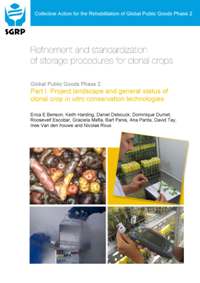 |
Part I, Project landscape and general status of clonal crop in vitro conservation technologies, introduces the GPG2 project within the CGIAR landscape and overviews the status of in vitro plant conservation in the wider conservation community of practice. This part describes the role of risk and quality management for the effective maintenance of in vitro genebanks in the context of research and the development and validation of best practices.
Authors: Erica E Benson, Keith Harding, Daniel Debouck, Dominique Dumet, Roosevelt Escobar, Graciela Mafla, Bart Panis, Ana Panta, David Tay, Ines Van den Houwe and Nicolas Roux
Reviewed by: Sarah E Ashmore and Barbara M Reed
Publication Year: 2011
Pages: 82
ISBN: 978-92-9043-905-9
Language: English
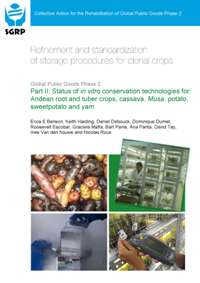 |
Part II, Status of in vitro conservation technologies for Andean root and tuber crops, cassava, Musa, potato, sweetpotato and yam, provides a status update on the mandate clonal crops. As tasked by GPG2, it includes lessons learnt, critical point analyses and the priority research needs of CGIAR’s in vitro genebanks.
Authors: Erica E Benson, Keith Harding, Daniel Debouck, Dominique Dumet, Roosevelt Escobar, Graciela Mafla, Bart Panis, Ana Panta, David Tay, Ines Van den Houwe and Nicolas Roux
Reviewed by: Joachim Keller and Florent Engelmann
Publication Year: 2011
Pages: 106
ISBN: 978-92-9043-906-6
Language: English
Please click here for full size PDF (9 MB)
 |
Part III, Multi-crop guidelines for developing in vitro conservation best practices for clonal crops, is a compilation of quality and risk management best practices and guidelines from both plant and other bioresources communities. This collective knowledge provided the foundation for developing the GPG2 multi-crop best practice guidelines. They are compiled in two parts. Section I comprises general operational guidelines for quality and risk management in in vitro plant genebanks. Section II provides generic, multi-crop technical guidelines for the medium-term (slow growth) and long-term (cryopreservation) storage of crop germplasm held in in vitro active genebanks (IVAGs) and in vitro base genebanks (IVBGs) respectively.
Authors: Erica E Benson, Keith Harding, Daniel Debouck, Dominique Dumet, Roosevelt Escobar, Graciela Mafla, Bart Panis, Ana Panta, David Tay, Ines Van den Houwe and Nicolas Roux
Reviewed by: David Galsworthy, Florent Engelmann and David Ellis
Publication Year: 2011
Pages: 144
ISBN: 978-92-9043-833-5
Language: English
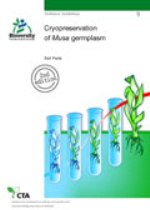 |
Technical Guidelines 9: Cryopreservation of Musa germplasm, 2nd edition (1.3MB)
The aim of this publication is to provide information and guidance on cryopreservation methodologies suitable for use on Musa germplasm. The different methods currently used at Katholieke Universiteit Leuven (KULeuven) for cryopreserving Musa cultures are described as well as the advantages and disadvantages of each of them. The areas where research is still required to further optimize the protocols are also identified. It is hoped that the detailed descriptions of the methodologies will facilitate their adoption and standard use in different laboratories.
Author: Panis, B. Edited by Erica Benson and Florent Engelmann
Publication Year: 2009
Pages: 51
ISBN: 978-2-910810-86-3
Language: English (also available in French and Spanish)
 |
Handbooks for Genebanks No. 7:
Technical guidelines for the management of field and in vitro germplasm collections
Plant species that are vegetatively propagated, that have long life cycles and/or produce nonorthodox seeds are traditionally maintained in field collections. Maintaining plants in the field is costly and carries high risks of loss; therefore, the strategies and procedures employed to establish and maintain field collections need to be practical, rational and economic, in addition to being scientifically sound. Experience in cost-effective management of field collections lies with individual curators and is not readily available to guide others. Further, there are increasing opportunities for using in vitro methods for the conservation of crops normally conserved in the field, and there is a need to develop strategies and procedures for managing in vitro collections as routine and integral part of the overall conservation strategy of a crop or collection.
Authors: Reed, B.M.; Engelmann, F.; Dulloo, M.E.; Engels, J.M.M.
Publication Year: 2004
Pages: 106
ISBN-10: 92-9043-640-9
ISBN-13: 978-92-9043-640-9
Language: English
 |
IPGRI Technical Bulletin No. 7: In vitro collecting techniques for germplasm conservation (0.6MB)
During the early 1980s, while searching for ways to more fully utilize the techniques of plant biotechnology, IPGRI (the International Plant Genetic Resources Institute, then the International Board of Plant Genetic Resources, IBPGR) suggested that germplasm be collected by means of in vitro methods. Between 1990 and today, research in this area has been performed by different groups, leading to the development and/or optimization of in vitro collecting techniques for various additional species including coconut, taro, tropical rainforest tree species and wild and endangered species.
This Technical Bulletin comprises three separate parts. The first part (theoretical background to in vitro collecting), consists of three chapters regarding the rationale behind the development of in vitro collecting and its potential for the conservation of crops and wild or endangered species and the control of contamination, a critically important step which conditions the successful development of any in vitro collecting protocol.
The second part (case studies) comprises nine chapters, each describing the work performed for the development of in vitro protocols for a particular species or group of species. The protocols described can be applied directly for collecting germplasm of any of the species concerned. However, circumstances will differ from one collecting mission to the next and it can be expected that these protocols will have to be adapted to these circumstances. Therefore, the aim of these chapters is to illustrate the range of protocols, from the simplest to the most sophisticated, which can be developed for in vitro collecting germplasm of a given species and to highlight the critical steps of such protocols. Such information should be used by the readers as a guide for the development of protocols for the species of their own interest.
The last part (prospects) consists of a single chapter which analyses the future of in vitro collecting for improving the conservation and use of plant genetic resources.
This Technical Bulletin includes references up to 2001. It includes both theoretical and practical aspects, aims to provide a resource for those wishing to understand the basic concepts of adapting plant tissue culture methods to field collecting.
Authors: Valerie C. Pence, V.C.; Sandoval, J.A.; Villalobos, V.M.; Engelmann, F. (eds.)
Publication Year: 2002
Pages: 100
ISBN-10: 92-9043-534-8
ISBN-13: 978-92-9043-534-1
Language: English
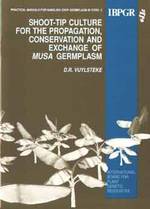 |
Practical manuals for Handling Crop Germplasm In Vitro 2:
Shoot-tip Culture for the Propagation, Conservation and Exchange of Musa Germplasm (This manual can be purchased via Bioversity's website here)
This publication reviews in detail the history of shoot-tip culture of Musa, in vitro propagation procedures, in vitro conservation, germplasm exchange using in vitro cultures and potential problems.
Authors: Vuylsteke, D.R.
Publication Year: 1989
Pages: 56
ISBN-10: 92-9043-140-7
ISBN-13: 978-92-9043-140-4
Language: English
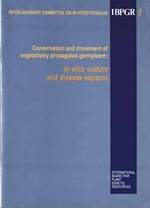 |
IBPGR Advisory Committee on In Vitro Storage: Report of a Subcommittee Meeting: Conservation and Movement of Vegetatively Propagated Germplasm: In Vitro Culture and Disease Aspects (Available in HTML version)
This report examines the problem and reviews the mid-1987 status of some major crops. It looks at the scope available for improvement, for example in in vitro transfer of germplasm and improved indexing, and makes recommendations for future action. Also included are eight reports outlining the status of a number of crops.
Authors: IBPGR
Publication Year: 1988
Pages: 60
ISBN-10: 92-9043-125-3
ISBN-13: 978-92-9043-125-1
Language: English
For more manuals on this topic, please visit the Bioversity International website here.
Comments
- No comments found





Leave your comments
Post comment as a guest